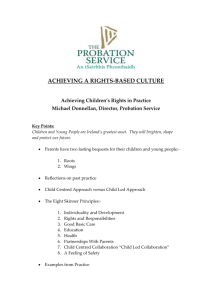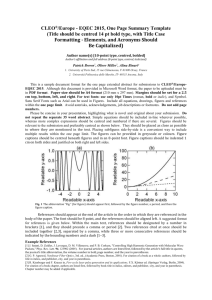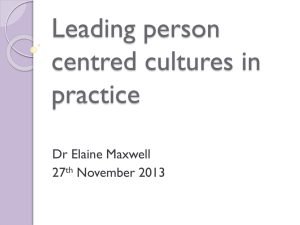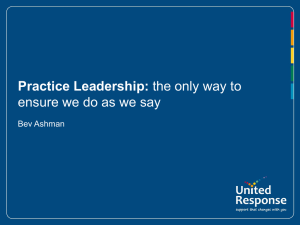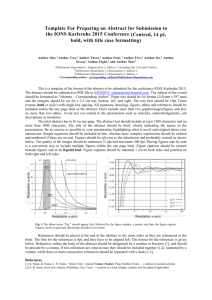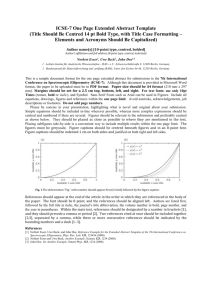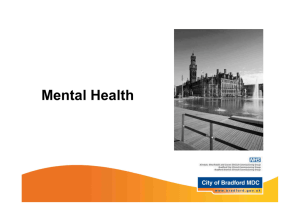person centred practice approach
advertisement
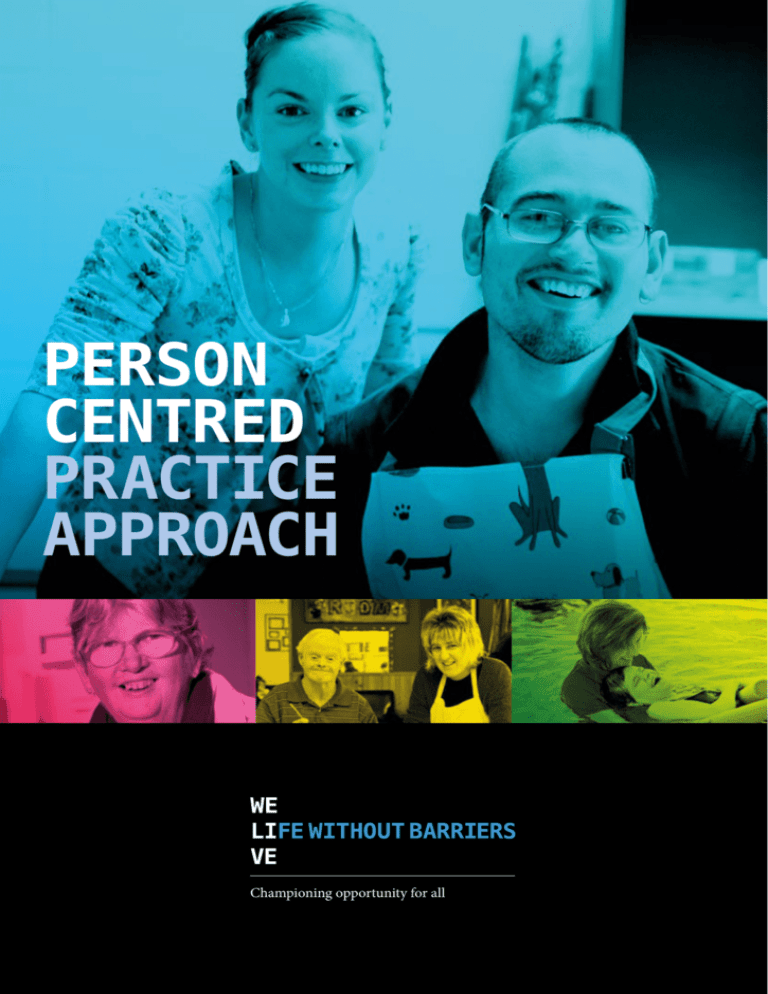
PERSON CENTRED PRACTICE APPROACH Championing opportunity for all PERSON CENTRED PRACTICE APPROACH 1.PURPOSE The Life Without Barriers Person Centred Practice Approach (the Approach) is a resource for the Board, Executive and senior management, managers and staff in Disability Services and corporate functions within Life Without Barriers to assist in the promotion, communication and delivery of person centred approaches. It is intended to support a whole of organisation approach to person centred work, directly with clients and their support networks, in managing, supporting and building capability in the LWB workforce, and in building capacity and partnership with other agencies, funding bodies and communities. 2.OBJECTIVES The Approach will: • promote client participation • promote a consistent approach to the adoption and implementation of person centred values • provide a consistent approach to LWB person centred policy and documentation • build staff confidence in person centred approaches • enhance and build on existing work in person centred approaches • assist managers to improve consistency for staff and clients but be flexible enough to allow for responsiveness to local differences • provide clear definitions about what is expected in LWB in relation to person centred practice across all key areas of work in disability services • provide direction on targets for person centred approaches and suitable implementation strategies • provide LWB person centred principles to drive practice • reflect best practice and industry standards • describe appropriate person centred tools and resources • identify systems and structures to support practice development and professional development • establish the governance approach to facilitate national strategies, showcase innovation and creativity, endorse person centred strategies, tools and resources and reporting mechanisms • promote continuous improvement. 3.CONTEXT Complementing the Pillars of Practice framework, the Disability Services Person Centred Practice Approach sits within the suite of LWB strategic documents, and provides foundational information for: • managers and staff – about what it means to work for LWB, and • clients, families and communities – about what they can expect from LWB when they receive services and supports • partners and funders – about what is important to LWB as an organisation. The core components of the Person Centred Practice Approach align and add value to the LWB core values, vision, mission statements and strategic directions. They are an additional resource for management and staff to enhance their work in assisting people with disabilities to achieve their goals and aspirations and to support innovative and creative solutions to building workforce capacity in delivering person centred programs, services and supports. LWB – VALUES We build relationships We are imaginative We are respectful We are responsive We are courageous LWB – PRACTICE FRAMEWORK PILLARS Listen to our clients Respect culture Plan with the individual Supervise our staff well Work as a team Choose the model that works LWB DISABILITY SERVICES PERSON CENTRED PRACTICE APPROACH Support consistent practice Define the LWB person centred approach Promote person centred outcomes Build staff confidence PERSON CENTRED PRINCIPLES AREAS TO FOCUS TO EMBED A PERSON CENTRED APPROACH Outcomes for people Community inclusive Leadership Shared values and beliefs Empowered staff PERSON CENTRED TOOLS AND RESOURCES Learning Partnership 4|5 4.DEFINITIONS OF PERSON CENTRED ACTIVITIES PERSON CENTRED All thinking and actions are based upon what is important to the person from their own perspective and that contributes to their full inclusion in society.1 PERSON CENTRED ORGANISATIONS Person Centred organisations: • have committed leadership that actively instils the vision of a person centred approach at all levels • are open to continual learning about how to implement a person centred approach • consciously hold positive beliefs about people with a disability and their potential • develop equal and ethical partnerships with people with a disability and their families • work with people individually to meet each person’s needs so that they can be in valued roles in valued settings • develop appropriate organisational structures and processes.2 • promote a ‘person centred culture’ whereby behaviours, language and symbols, and systems and processes are person centred. PERSON CENTRED APPROACHES Person centred approaches are: ‘ways of commissioning (funding), providing and organising services rooted in listening to what people want, to help them live in their communities as they choose. People are not simply placed in pre-existing services and expected to adjust, rather the service strives to adjust to the person. Person centred approaches look to mainstream services and community resources for assistance and do not limit themselves to what is available within specialist services.’ 3 Person centred approaches include a broad range of actions at individual, organisational, systemic and community levels to support and facilitate the person with a disability being listened to and placed at the centre including: • planning processes using a range of tools and resources • person centred thinking • service delivery • service design •communication • community work. Person Centred Approaches include: • Person Centred Thinking which is seen as ‘the foundation for person centred planning’ 4 and a set of values, skills and tools used in getting to know someone, what they find important and what they want out of life. Person centred thinking can be thought of as a philosophy, a way of thinking or mindset which involves viewing, listening to and supporting a person with a disability based on their strengths, abilities, aspirations and preference to make decisions to maintain a life which is meaningful to them. Person centred thinking is the basis for action in all kinds of situations, helping us plan, organise, and to understand and connect with communities. It is seen as the foundations of how people (and organisations) work with people with disability. • Person Centred Planning ‘is a way of discovering what people want, the support they need and how they can get it. It is evidence based practice that assist people in leading an independent and inclusive life. Person centred planning is a set of tools for change at an individual, and an organisational level. It shifts the power from professionals to people who use services.’ 5 Person centred planning puts the person with disability at the centre of the planning, listens deeply to them and their family and friends, learns over time what it is they want for their life now and in the future, and then acts on this. Person centred planning is the basis for problem solving and negotiation to mobilise the necessary resources to pursue a person’s aspirations. These resources may be obtained from someone’s own network, service providers or from non specialist and non service sources. 1 Adapted from Valuing People. UK Department of Health. 2001 2 Ellis, J et al., Working in Person Centred Ways: A resource book for NSW advocacy and information services. Ageing Disability and Home Care, Dept of Family and Community Services. NSW 2012 3 Valuing People – A New Strategy for Learning Disability for the 21st Century. Guidance for Implementation Groups, http://valuingpeople.gov.uk 4 Department of Health (2010) Personalisation through Person Centred Planning: http://www.thinklocalactpersonal.org.uk 5 Valuing People – A New Strategy for Learning Disability for the 21st Century. Guidance for Implementation Groups, http://valuingpeople.gov.uk 4.DEFINITIONS OF PERSON CENTRED ACTIVITIES The key features of person centred planning are: • the person is at the centre • family members and friends are full partners • the plan reflects the person’s capacities, what is important to the person and specifies the support they require to make a valued contribution to their community • the plan builds a shared commitment to action that will uphold the person’s rights • the plan leads to continual listening, learning and action and helps the person to get what they want out of life. • Individual Funding ‘Individual funding is one mechanism for enabling flexibility, it means the money to support the person is allocated either directly (direct funding / self managed) to the person instead of to a service agency or to a third party financial intermediary to purchase services and supports as directed by the person with disability and their support network.’ 6 • Family Centred approaches Family centred practice is a set of values, skills, behaviours and knowledge that recognises the centrality of families in the lives (CONTINUED) of children and young people. It is grounded in respect for the uniqueness of every person and family, and a commitment to partnering with families and communities to support children and young people with a disability to learn, grow and thrive. It puts family life – and the strengths, needs and choices of people with a disability and their families – at the centre of service planning, development, implementation and evaluation.7 5.PERSON CENTRED OUTCOMES INDIVIDUALITY CHOICE PRIVACY INDEPENDENCE INCLUSION everyone’s differences are recognised and respected the right of individuals to make informed choices, and take responsibility for those choices and related risks is supported information and activities are kept confidential individuals are empowered to do activities for themselves and their dignity be treated in a respectful way people are supported to be participate in all aspects of community that they choose and viewed as valued and equal citizens 6 Kirkman, M., Literature Review: Person Centred Approaches to Disability Service Provision. 2010. University of Melbourne 7 Department of Human Services and Department of Education and Early Childhood Development 2011, Family-centred, person-centred organisations: a guide for managers and governance bodies to support whole-of-organisation approaches to family-centred practice, State Government of Victoria, Melbourne. 6|7 6.PERSON CENTRED PRINCIPLES PERSON AT THE CENTRE The person with disability is central to all planning and decision making that helps achieve her or his preferred lifestyle. The person chooses the level of participation in planning according to her or his preference and ability, and is encouraged and supported to have as much control as possible over the whole planning process. INCLUSIVE AND ACCESSIBLE LWB is committed to contributing people with disability living in accessible and well designed communities with opportunities for full inclusion in social, economic, sporting and cultural life. FOCUS ON OUTCOMES All direct and indirect service design and delivery activity is focused on achieving positive outcomes for people with disability. INCLUSION OF OTHERS In accordance with the person’s wishes, family members, friends, significant others and other service providers are actively included in the all processes that support ongoing involvement in the person’s life, and encourage and assist growth of the person’s networks and community engagement. Fostering community connections in which individuals can develop relationships, learn, work/produce income, actively participate in community life and achieve their full potential. 8 PERSONAL PRIORITIES AND STRENGTHS LWB service design and delivery is oriented towards the person’s present and future priorities, and focuses on the person’s abilities, interests, dreams and aspirations, and the supports required to realise them. Seeking to understand individuals in the context of their age, gender, culture, ethnicity, belief system, social and income status, education, family, and any other factors that make them unique. SHARED COMMITMENT All those involved in service design and delivery to a person commit to changes that the person and those close to the person have agreed are needed to achieve a lifestyle of his or her choice. RESPECTS CULTURE LWB service delivery respects the culture, language, religious beliefs and priorities of all people. Planning with a person is undertaken with regard to social customs and traditions, and the individual’s own culture and beliefs. SHARED COMMITMENT All those involved in service design and delivery a person commit to changes that the person and those close to the person have agreed are needed to achieve a lifestyle of her or his choice. CONTINUOUS PROCESS Service design and delivery with the person with a disability at the centre is a continuous process of listening, learning and further action and is not a one-off event. It is based on the assumption that people with disability have futures, and that their aspirations will change and grow with their experiences. REGULAR REVIEW AND CONTINUOUS IMPROVEMENT Service design and delivery is reviewed with the person and their support network at regular intervals to assess ongoing changes and learnings, and to ensure that planned activities are being achieved and are still relevant to the person’s goals. Person centred indicators of success are important for the person, LWB staff and LWB as a whole. ONE PERSON, ONE PLAN Planning is coordinated across all domains of a person’s life, including all specialist services being accessed as well as informal supports and networks, in so far as the person wants this to happen8. NSW Department of Family and Community Services, Ageing, Disability and Home Care, Lifestyle Planning Policy, March 2011, amended 2012. 7.A HUMAN RIGHTS PERSPECTIVE The Life Without Barriers Person Centred Practice Approach (the Approach) recognises the importance of the United Nations Convention of The Rights of Persons with Disabilities (2006). The Convention aims to enhance opportunities for people with disability to participate in all aspects of social and political life including access to employment, education, health care, information, justice, public transport and the built environment. The Convention outlines the rights of people with a disability as: • equality before the law without discrimination • make their own decisions • have their family life respected • freedom from exploitation, violence and abuse • an inclusive education • a decent standard of living • support to participate in society and live in the community • accessible physical environments and information. 8|9 8.AREAS OF FOCUS TO EMBED A PERSON CENTRED PRACTICE APPROACH The Areas of Focus to embed a person centred practice approach in LWB Disability Services9 are summarised in the diagram below: LEADERSHIP •Establishing direction •Aligning people to direction •Motivating and inspiring SHARED VALUES AND BELIEFS OUTCOMES FOR INDIVIDUALS INCLUSIVE COMMUNITIES •Re-establish values •Focus on people •Participation in community •Messaging •Individual goals •Inclusion •Governance •Drive plans •Managing challenges and barriers •Formal and informal networks •Community mapping •Relationship EMPOWERED AND VALUED STAFF INDIVIDUAL AND ORGANISATIONAL LEARNING PARTNERSHIPS •Values based recruitment •Reflective practice •Professional •Role clarity •Continuous Improvement •Families / carers •Communities of practice •People •Empowerment •Supervision and coaching •Recognition •“Belonging” •Structured learning •Safeguarding The areas of focus to embed a person centred practice approach are applicable to all layers of the organisation including: • individual – knowledge, attitudes and behaviours supporting person centre approaches • professional – person centred practice is an important component in education and professional development • organisational – culture is created where the skills and resources required for person centred approaches are integral to core business 9 • service system – policy and procedures for person centred practice are effective when placed in all sectors and the service system, and mechanism and sufficient resources for fostering and monitoring and reviewing person centred practice are present at all other levels.10 Adapted from Williams, R. and Sanderson, H. What are we learning about person centred organisations? http://www.helensandersonassociates.co.uk/media Family-centred, person centred organisation – a guide for managers and governance bodies to support whole-of-organisation approaches to family centred practice. Dept of Human Services and Dept of Education and Early Childhood Development. Victoria., 2012 10 •Strategic •Community 8.AREAS OF FOCUS TO EMBED A PERSON CENTRED PRACTICE APPROACH (CONTINUED) 8.1 FOCUS ON LEADERSHIP Leaders have three key responsibilities in person centred organisations: • establishing direction which includes the vision and strategies for producing the change necessary to achieve the vision • aligning people to the direction which involves communicating vision in ways that influence people to make it happen • motivating and inspiring which includes energising people to overcome barriers and obstacles to change • person centred organisations require leaders at all levels who are prepared to say that the organisation, the team, the staff that they lead is person centred and act on that basis. People in positions of authority (team leaders, manager, directors, coordinators, senior managers, Board members) have a role in supporting the vision of being person centred and lead the implementation of person centred strategies across their areas of responsibility whether it is direct service delivery, human resources, management, finance or administration. A leader can be anyone who helps define and change the ways things are done. Frequently the person centred strategies may be under developed or different elements may not be integrated. It is the role of the leader to build connections to support person centred strategies across all areas of the organisation. ALIGNING PEOPLE TO THE DIRECTION MOTIVATING AND INSPIRING LEADERSHIP ESTABLISHING DIRECTION SUPPORTING THE PERSON CENTRED VISION Communicating the vision needs to occur as often as can be managed through: • formal channels – reports, presentations, team meetings, interagency meetings, and • informal channels – group discussion, lunch rooms, networking • the leader’s behaviour. • be a coach to new people or team members • keep people informed • be constructive • be an ideas person • recognise and celebrate achievements • ensure regular team meetings celebrate and share good practice • provide the team with a framework for thinking through difficult situations • use person centred planning and thinking tools with your team or colleagues. Some of the things a leaders can do to support person centred approaches include: • work with the team to deliver what is important to the people they support • work with the team to fulfill the purpose and strategy of the organisation 10|11 8.2 SHARED VALUES AND BELIEFS Person centred values need to continually be re-established in our work to ensure that everyone who works for, and with our organisation knows exactly what our values are. The LWB Board recently refreshed to the LWB values to reflect how we work with people within a person centred approach. WE BUILD RELATIONSHIPS WE ARE IMAGINATIVE Key questions: • how do I communicate my commitment to the LWB values in what I say and how I behave? • what messaging can I use with staff, clients and families and the community to clearly communicate the LWB values? • how are the values demonstrated in the governance arrangements that I lead or participate in? WE ARE RESPECTFUL RE-ESTABLISH VALUES WE ARE RESPONSIVE WE ARE COURAGEOUS MESSAGING SHARED VALUES AND BELIEFS GOVERNANCE COMMUNICATION AND LANGUAGE 8.AREAS OF FOCUS TO EMBED A PERSON CENTRED PRACTICE APPROACH (CONTINUED) 8.3 FOCUS ON OUTCOMES FOR INDIVIDUALS Person centred organisations need to focus on the people they support and not just on the services they provide. This means that the goals and aspirations of the people we support should be uppermost in all our minds when we plan, design and deliver services and supports. The key is to listen to people. Key questions include: • is this activity about the people we support at LWB? • does this activity reflect the needs and aspirations of the people supported by LWB? • what can I do to remove the challenges and barriers to achieving the goals of the people we support at LWB? • how is the person being supported to participate, make choices and decisions? • what does success look like for the person? • which outcomes domains are important to the person? FOCUS ON PEOPLE INDIVIDUAL GOAL DRIVEN PLANS OUTCOMES FOR INDIVIDUALS MANAGING CHALLENGES MANAGING BARRIERS 12|13 8.4 FOCUS ON INCLUSIVE COMMUNITIES Person centred organisations seek to play a role in the communities in which they work. It is clear in the research that people with disability, their families and carers are more likely to live full and fulfilling lives if they are supported in their communities. Community networks provide an opportunity for people to contribute to their local communities, to develop relationships as part of that, and to be valued as a consequence of both. From a person centred approach we all can: • encourage connections with people and their families, friends and informal support networks • work with non disability services to assist them to support people with disability into their programs and activities • develop community maps so we know where community assets are, community networks and pathways for people with a disability, and more broadly • build good connections and understanding in the community to safeguard and mitigate risks • encourage and support positive nurturing relationships • build and develop strong positive formal and informal networks and partnerships. RELATIONSHIPS AND PARTICIPATION IN COMMUNITY INCLUSION AND SAFEGUARDING INCLUSIVE COMMUNITIES MANAGING CHALLENGES MANAGING BARRIERS 8.AREAS OF FOCUS TO EMBED A PERSON CENTRED PRACTICE APPROACH (CONTINUED) 8.5 FOCUS ON EMPOWERED AND VALUED STAFF Person centred approaches to people with disability highlight the importance of treating people with dignity and respect, to focus on individual strengths and use every opportunity to explore options to solve problems, break down barriers and support people to reach their goals. Staff who are valued and empowered to make decisions, take risks, be creative are more likely to be able to provide care and support from a person centred approach. Staff thrive on making a difference and being recognised for achievements. Staff generally have the best interest of the people they support and one another in the work they do and will work together to achieve outcomes that they can be proud of. This means that manager can ‘let go’ and trust staff to do their jobs. Managers can provide coaching and mentoring, good quality supervision using person centred tools, maintain connected positive dialogue and set clear directions. Some ways to demonstrate to staff that they (and their colleagues) are valued include: • recruit great staff with great values • train staff giving them clarity around their values • support staff through coaching and supervision • encourage, praise and reward staff for their achievements • support staff who are struggling • develop and maintain an organisational culture where staff are valued and feel part of the organisation • use the person centred tools with staff • create a shared understanding of what success looks like for staff. VALUES BASED RECRUITMENT AND BELONGING ROLE CLARITY AND RECOGNITION EMPOWERED AND VALUED STAFF EMPOWERMENT AND FOCUSED SUPPORT SUPERVISION AND COACHING 14|15 8.6 FOCUS ON INDIVIDUAL AND ORGANISATIONAL LEARNING The disability work environment is in a continual state of change with multiple and complex demands being made on all management and staff at all levels. The introduction of the NDIS and individual funding, new quality frameworks, changes in the funding arrangements with government and requirements to be flexible and responsive to a broader more diverse client base means that staff knowledge, skills and experiences needs to be continually assessed and updated. The challenge for each staff member at LWB is to learn from our experiences and adjust to changing circumstances to ensure that service assist people with disabilities to reach their goals and improve their outcomes. Ways in which LWB can ensure ongoing learning include: • provide and promote opportunities for reflective practice in team meetings, through formal supervision, with peers, with professional group • allow time and consistent effort to develop communities of practice to explore creative innovative solutions, best practice, new ideas and ways of working from person centred approaches • establish clear structured learning pathways for staff that at all levels form induction, front line, professional, management and senior leadership groups • ensure continuous improvement through benchmarking, assessment, and review and feedback mechanisms. REFLECTIVE PRACTICE CONTINUOUS IMPROVEMENT INDIVIDUAL AND ORGANISATIONAL LEARNING COMMUNITIES OF PRACTICE STRUCTURED LEARNING 8.AREAS OF FOCUS TO EMBED A PERSON CENTRED PRACTICE APPROACH (CONTINUED) 8.7 FOCUS ON PARTNERSHIPS People with disability, families and carers, government bodies, other disability service providers and mainstream services all have a contribution to make to building inclusive responsive communities where people with disability are valued and equal citizens. Through partnerships, LWB and its staff can support people with disability to achieve their goals and live an ‘ordinary life’. From a person centred approach key partnerships include: • people with disability • their parents/ carers / support networks • community members and community connectors (elders) • professional and clinical groups • the broader community • other disability service providers • mainstream organisations • corporate enterprise and business • advocates (or groups). All staff at LWB have the skills and expertise in developing partnerships either on an individual level to support a person with a disability to access community activities or services, on a professional level to develop better tools and resources, or on a systemic level to support and foster change in attitudes and acceptance. Strong, sustainable and positive partnerships are a key foundation to person centred practices. STRATEGIC AND CORPORATE PROFESSIONAL PARTNERSHIPS COMMUNITY Key partnerships are those that: • provide universal services – transport, leisure, health, education, housing and access to information and advice • promote choice and control – shaping services to meet people’s needs rather than shaping people to fit in with the services offered • build social capital – care and support that individuals and their carers can get from their local community and friends, neighbours or community groups • provide early intervention and prevention – support that is available for people who need help to stay independent for as long as possible in their own home. PEOPLE FAMILIES CARERS 16|17 9.PERSON CENTRED PRACTICE TOOLS AND RESOURCES COMMUNICATION CHART LEARNING LOG Provides information about how people communicate. Ways to use can include: people with disability, staff, families / carers, community groups, other providers, advocates. Enables the collection of information to help to provide effective support. This can be used with an individual, with families, as a supervision tool or with community. BLUE SKY THINKING Useful when people are stuck. When there needs to be more than one idea about what to do next. This is a problem solving tool that is useful in planning and team meetings. MCGILL ACTION PLANNING SYSTEM (MAPS) There is a focus on gathering information about the person, developing a ‘dream’ and working towards the ‘dream’. Good information gathering tool to be used in the early stages of planning for any purpose. GOOD DAY... BAD DAY Information gathering tools for individuals, families, service providers, staff and recruitment. PRESENCE TO CONTRIBUTE Helps by asking what activities or interests people can have in the community and how these could be developed. Looks at ways of increasing participation and involvement. ONE PAGE PROFILE A short introduction to a person with key information on a single page which provides an understanding of the person and how best to support them. It is not a person centred plan. Can be used for staff, team building, building a person centred culture. ESSENTIAL LIFESTYLE PLANNING IMPORTANT TO... AND IMPORTANT FOR... Looks at the person’s life now and is a good tool for seeing what’s not working well now. It does not look at the person’s ‘dream’ but focuses on support that is to be provided on a day-to-day basis in a way that makes sense for the person. Used in balancing between needs and wants. Ways to use include individuals, team planning, community planning, services design. 9.PERSON CENTRED PRACTICE TOOLS AND RESOURCES (CONTINUED) RELATIONSHIP CIRCLE ROLES AND RESPONSIBILITIES Records who is in the person’s life. It helps to find out who is important, strengthen relationships, the gaps and work out what needs to be done to increase who is in the person’s life. This can be useful in team and community capacity building. Helps clarify staff roles and responsibilities and establish the best way to support the person, roles of service providers and develop creative and effective ways of supporting people. DOUGHNUT Helps paid staff and others to think about their roles and responsibilities in supporting a person by identifying ‘core responsibilities’, areas where they could provide support, ‘judgement and creativity’ and ‘not our responsibility,’ and where staff should not become involved. WHAT’S WORKING... WHAT’S NOT WORKING Enables the person and those supporting them to reflect on how things are going, to solve problems and set action to makes changes. Useful when working with teams, families, interagency work. PERSON CENTRED PLAN A process for learning how someone wants to live and developing a plan to make it happen. What is important, what support is needed and actions to support the person get what is important to them. MATCHING TOOL Aims to get a good match between those who need support and the people providing support. Can be used for individuals, volunteers, informal support, staff, coaching and mentoring, building teams. Also to develop ‘job description’ and recruit paid or unpaid staff. DECISION MAKING AGREEMENT Documents what decisions the person wants to be involved in. Can be useful in managing risk and ensuring individual’s views are valued. Looks at what support someone needs to make decisions in their life and ensures that they have as much power and control as possible. PERSONAL FUTURES PLAN Involves getting to know the person and what their life is like now, what the person would like in the future and taking action to move towards this desirable future. Involves possibilities in the community and looks at what needs to change in services. DREAMING This helps people think about the future and their goals, can be useful with people, families, community, staff teams and organisational planning. 18|19 PLANNING ALTERNATIVE TOMORROWS WITH HOPE (PATH) Is a planning tool that develops a vision of a desirable future that can be used with individuals, teams, interagency work, community planning, business planning. COMMUNITY MAPPING A community map can be drawn by a diverse group of people from a community. The aim is to widen the perspective towards community resources and to foster new connections into the community. 4 PLUS 1 QUESTIONS This reflective tool can be used to think about what staff or others understand about a person and what needs to change. This tool helps to reflect on understanding about a person or issue, promote understanding in team meetings or supervision and explore issues more widely with family, program areas, community. REFERENCES Ellis, J et al., Working in Person Centred Ways: A resource book for NSW advocacy and information services. Ageing Disability and Home Care, Dept of Family and Community Services. NSW 2012. Department of Health (2010) Personalisation Through Person Centred Planning. http//www.thinklocalactpersonal.org.uk Kirkman, M., Literature Review: Person Centred Approaches to Disability Service Provision. 2010. University of Melbourne. Department of Human Services and Department of Education and Early Childhood Development 2012, Family-centred, person-centred organisations: a guide for managers and governance bodies to support whole-of-organisation approaches to family-centred practice, State Government of Victoria, Melbourne. Valuing People – A New Strategy for Learning Disability for the 21st Century. Guidance for Implementation Groups, http://valuingpeople.gov.uk. Williams, R. and Sanderson, H. What are we learning about person centred organisations? http://www.helensandersonassociates.co.uk/media NSW Department of Family and Community Services, Ageing, Disability and Home Care, Lifestyle Planning Policy, March 2011, amended 2012. Life Without Barriers 352 King Street Newcastle NSW 2300 T. 02 4033 4500 E.info@lwb.org.au W.www.lwb.org.au TOLL FREE 1800 WE LIVE (1800 93 5483) @lwbaustralia LWBAustralia YouTube
